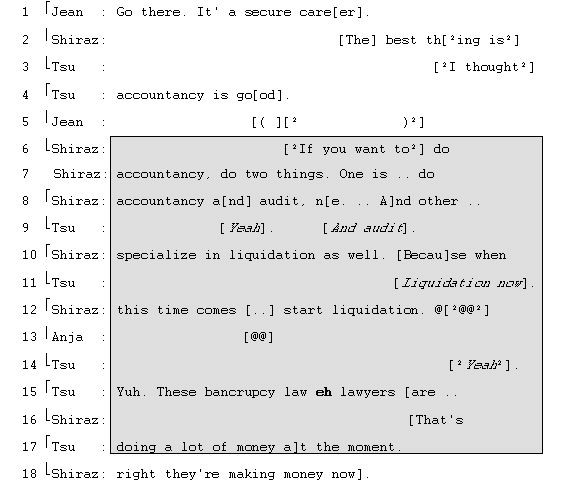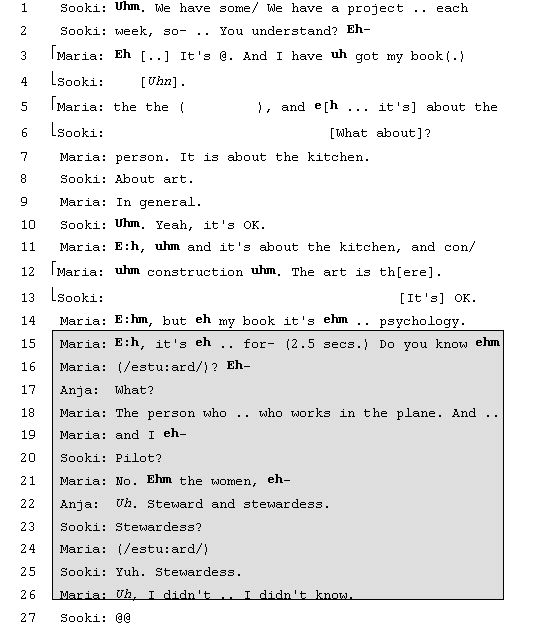Guidelines for extensive reading of ESP texts on the use of English for European business
Christiane Meierkord’s analysis of non-native-/non-native interaction in English is based on the corpus of students’ small talk conversations. The corpus reflects demographic characteristics of the speakers, who were grouped together by the factors of cultural similarity and the speakers' communicative competence. The aim of the study was rather to characterize the speakers’ lingua franca English in general terms of quantitative conversation analysis. The speakers’ discourse structure is considered to consist of an opening, a core and a closing phase. Their lingua franca communication is argued to be a form of intercultural communication characterised by cooperation rather than misunderstanding. Christiane Meierkord’s data reveals that lingua franca English is highly heterogeneous, which causes problems for the application of traditional approaches to conversation in native speaker discourse.
Text 2-23.CROSS-CULTURAL AND INTERCULTURAL DATA ON
NON-NATIVE/NON-NATIVE LINGUA FRANCA INTERACTION
(Based on Christiane Meierkord’s analysis of non-native-/non-native small talk conversations in English. Continued from Text 1-23)
Cross-cultural contrastive discourse analysis
Evidence from languages other than English has further proven that existing definitions of the turn need to be modified before being applied to cross- or inter-cultural data. In his observations in the Antiguan speech community, Reisman (1974) found that unlike the case with speakers of English overlapping speech is neither cut off nor 'repaired'. Rather, the current speaker continues speaking when another participant starts her utterance. In her study of conversations between New Yorkers and Californians, Tannen (1984) also identified cross-cultural misunderstandings regarding those overlaps that have usually been termed turn-taking signals. New Yorkers obviously rather use overlaps to support the speaking partner by uttering short questions, while Californians take them for turn-claiming signals. Kotthoff (1993) therefore states that the status of an overlap as either being a support or rather an interruption needs to be negotiated during the course of the interaction. This, again, implies that a static, technical definition focussing on an isolated turn must necessarily fail.
Szatrowski (1993), who analysed the structure of Japanese conversation, also encountered problems with the concept of the turn. She claims that, different from English conversations in which for the most part one participant talks one-sidedly (in turn), it is a destinctive feature of Japanese conversations that one participant offers a piece of information and the other participant cooperatively completes a unit she calls wadan (information unit). The concept of wadan resembles that of the turn in its functional definition. A wadan has been completed when a semantic contents, which carries the conversation further, has cooperatively been negotiated. Within one wadan, participants exchange sense units, which may be sentences, phrases or single words.
Lingua franca data
In this chapter, two extracts from my corpus will be discussed at length. Despite their being enormously different with regard to the participants' linguistic actions, they are both representative of lingua franca interactions and reveal the heterogeneity which both the analysis of and interpretation of lingua franca interactions have to cope with.
Example 1. 
The brackets on the left side indicate simultaneous talk, and their number reveals that there is a high amount of simultaneous speech going on. It is important to note, that the three speakers who actively participate in this stretch of talk (Anja is passive) do obviously not regard each others' utterances as competitive. Rather, they react to the contents of each others' contributions and thus collaboratively achieve the completion of the wadan and the information expressed within this unit.
In line 2, Shiraz, an accountant, starts with an utterance stating his opinion about what is the best way to pursue a career in accountancy. He continues in line 6. At the same time, more or less, Tsu gives his impression of the profession: "I thought accountancy is good." in lines 3 to 4. Shiraz continues to talk about what he considers to be those special branches of accountancy which best assure a secure career in the field. He is supported by Tsu in line 9 "Yeah. And audit.", which restates the last part of Shiraz' utterance in line 8. In line 10, Shiraz reasons that a specialization in liquidation would also be useful. Towards this, Tsu reacts with "Liquidation now", which has more or less the same propositional content as Shiraz's next sentence implying that he considers a specialization in liquidation to be useful because of the present economic situation. The same occurs in lines 15 to 18. Shiraz and Tsu simultaneously express a very much similar contents, i.e. the affluence of bancruptcy lawyers.
In the above example, the two or three participants are not only supporting each other by using back-channels as in line 9, but they are also collaboratively achieving a certain meaning regarding the topic under discussion. The units discussed above are framed and shaded in grey. What both have in common is that they are completed when the participants have jointly negotiated the argument struture of the sequence's propositional content through addition of, deletion of and agreement on arguments.
The situation is somewhat different when less competent speakers interact in lingua franca English. This is the case in example 2, which will appear more 'orderly' than the example just discussed in that there is not much overlapping talk.
Maria, a Spanish student and Sooki, a Korean woman, negotiate the contents of a book Maria offers to lend to Sooki, who needs information on Spanish arts. In lines 1 and 3, Maria tells Sooki about the existence of the book and Sooki, in line 4, asks what the book is about more specifically ("What about?"). Maria immediately reacts to this short question (lines 3 and 4), but Sooki is obviously still not satisfied, as in line 6 she asks whether the book does in fact cover arts. Further down in lines 13 ff. Maria tries to clarify her notion of this book by telling Sooki for what kind of addressees it is intended. In the following sequence (lines 15 to 25), the participants collaboratively work out the content of what Maria wants to express, namely that this is a book for stewardesses.
Example 2.

Here, we can observe further features that occur frequently in my data: pauses, cut off utterances, restarts, hesitation phenomena and laughter, which do all occur within the wadan Sooki and Maria build by interactively reacting to each others' questions, hesitations and suggestions. Most of these features are due to the fact that the participants of these conversations are learners of English. Much more than native speakers, they need to re-plan their utterances. This results in pauses, hesitation and restarts. Such phenomena make it difficult for the analyst to assign stretches of talk or non-talk to single turns. In line 15, Maria starts her utterance by trying to express whom her book is intended for. Due to her lack of the vocabulary item stewardess, she needs to cut off her utterance. After approximately two seconds, she starts with a request for help by asking Maria and Anja whether they are familiar with the Spanish translation.
A synthesis
Evidence from Antiguan, Japanese and lingua franca English data reveal that a lot of the existing definitions and categories are ethnocentric constructs that do not stand a test with intercultural data and need re-definition. Taking into account the newest approaches regarding co-participation (Schegloff, 1996), collaborative construction of talk-in-interaction (Gramkow, Andersen, 1993 and Firth, 1990) and jointly constructed units of speech (Szartrowski, 1993) together with a combination of grammatical and semantic categories that account for possible units of collaboration may be rewarding in the explanation of lingua franca interactions. The unit of wadan, which is located somewhere between the turn and the exchange (in the sense of Discourse Analysis, cf. Coulthard (1985) or Stenström (1994)), may provide a category capable of grasping the heterogeneity encountered in lingua franca conversations.
